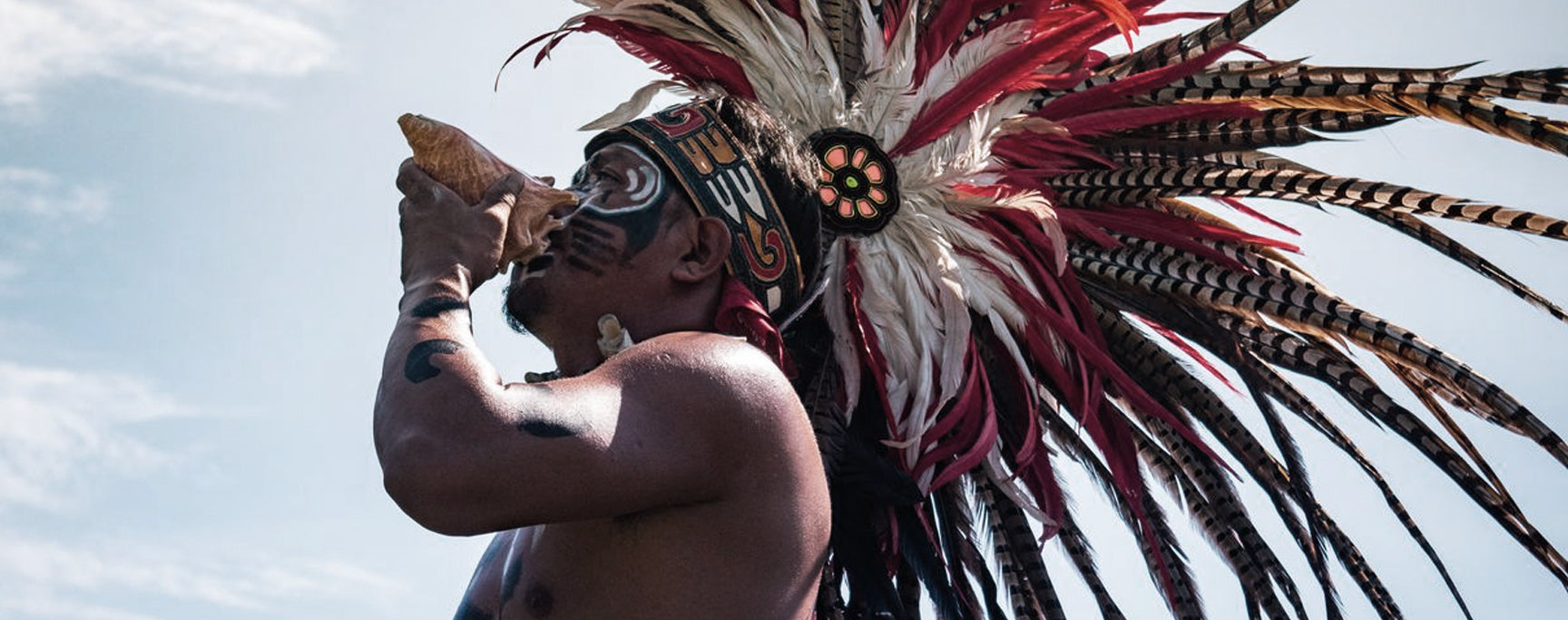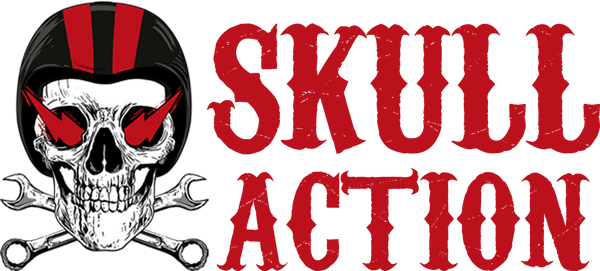The Day of the Dead or "Día de los Muertos" is a Mexican fiesta 🇲🇽 one of a kind. She is celebrated as a festive occasion where the living commemorate their dead through dance, music and a festive meal. What makes this celebration so special is its mixed origins, inspired by both pre-Columbian culture and the Christian culture that came with the Spanish colonists.
1) Multiple Origins of the Day of the Dead
A. Pre-Columbian Origins: Traditional Indian Rites
THE CULT OF DEATH IN CENTRAL AMERICA
The origin of the Day of the Dead in Mexico comes from the cult of death practiced more than 3,000 years ago by theindigenous peoples of America Central and Latin. The many pre-Colombian civilizations were at war with each other and the skulls of the defeated were kept as trophies 💀 During religious ceremonies, human skulls symbolized life and death. They are therefore very much represented in the paintings and engravings of this civilization.
LIFE AFTER DEATH ACCORDING TO THE AZTECS
Among the Aztecs, life and death are considered two sides of the same coin... so they did not fear death! We find among the Mexicans the same lightness in the approach to death. The Aztecs did not speak of hell or paradise according to the good or bad deeds of the living. Rather, they considered that one reached a different place after death depending on the circumstances of the death. In the event of natural death, the deceased had to make a long journey of 4 years to Mictlan (the world of the dead) to find Mictecacihuatl (the goddess of death). She is often represented by a skull and her cult has inspired many Day of the Dead traditions
RITUALS AND OFFERINGS TO THE DECEASED
In the Aztec culture, death is the beginning of a new life. The offerings are therefore intended to help the deceased in his new life and to meet his needs. These offerings were made during festivities around the summer with dancing and singing 💃 The Aztecs celebrated two feasts of the dead: a feast for children and a feast for adults. In the Mexican celebration we find this organization in two parts:- 1st November: the first day is called "Nuestros Angelitos" (our little angels in Spanish) and symbolizes the return of the spirits of the bereaved children.
- 2 November: the next day, the arrival of theadult adoptees, slower to make that journey between worlds.

B. Christian origins (Spanish missionaries)
CHRISTIAN RITES OF DEATH
However, the Day of the Dead is not a simple evolution of the Aztec people's cult of the dead. This festivity is the result of a blending of traditions with the contribution of Christian culture by the Hispanic settlers. In the sixteenth century, Spanish colonists conquered Latin America and set out to convert the natives to the Christian religion ✝️ Faced with the reluctance of the local population, the monks relied on local beliefs and existing rituals to make the connection with Christian rites. The Mexican feast of the dead was therefore gradually shifted from July to the 1st and 2nd of November to coincide with the feast of Christian All Saints' Day.
EUROPEAN FOLKLORE OF THE DAY OF THE DEAD
In the Christian tradition, the 1st of November corresponds to the Toussaint, where we celebrate all the saints of the Church. November 2nd is the day of commemoration of the deceased. On this day, families go to the cemeteries to take care of the graves and lay flowers in memory of the deceased. In the European folklore of the Middle Ages, we find the motif of the "macabre dance" present in engravings and paintings. These dancing skeleton motifs brought by Spanish missionaries may have inspired the representations of Mexican skeletons and skulls.
TWO CELEBRATIONS TO BECOME ONE.
"El Día de los Muertos" was revived in Mexico in the 1920s in a nationalist effort to revive Mexican culture. In this country very attached to religion, traditional folklore is revived through colourful costumes and Sugar Skulls, the famous “Calaveras”. These sugar skulls are used as offerings on altars for the deceased, as gifts for friends, but also as motifs for many decorations and accessories.
At Skull Action, we offer many accessories to pay tribute to this tradition straight from Mexico. One of the most popular is none other than this magnificent Mexican Skull Ring in Silver ! 🤩
2)Course of the Day of the Dead
A. Death-in-Practice Day
THE DECORATION OF TOWNS AND HOUSES
The pre-Columbian and Christian origins of the Feast of the Dead explain the unfolding of these special days. Usually it takes place on the 1st and 2nd of November. However, depending on the cities and regions, the festivities can last up to several weeks ! And from the beginning of October, the cities begin to prepare for the festivities with banners and decorations depicting colored skulls. In shop windows or in houses, one can find illustrations on the theme of the Day of the Dead, such as this superb Skull Clock !FAMILY VISITS TO THE CEMETERY
On the occasion of the Day of the Dead, families gather together to visit the tombs of their loved ones. Indeed, this event is considered to be the time when the spirits of the deceased return to earth to visit their families. It is common to see families picnicking in the cemetery on colourful tablecloths. In the house, on the street, or above the graves, the family erects an altar to lay traditional offerings. Among these offerings are fruits, sugar skulls (with the name of the deceased written on the forehead), fragrant flowers, tequila and candy 🍬. Holy water, candles and the bread of the dead inspired by the missionaries' Eucharist are also available. The altars are decorated with many colors (orange and red flower petals). Each family tries to erect an altar that is more sumptuous than their neighbour's and to please the deceased.
MAGNIFICENT FESTIVITIES AND PARADES
The traditional music and dance are an integral part of the celebrations. For the occasion, women wear skeleton make-up and colourful dresses. The big Mexico City parade brings together more than a million spectators who come to admire floats, dancers and puppeteers. The parade is a recent addition to the Feast of the Dead. Since 2016, it attracts a crowd of visitors eager for this exotic and surreal show. It is with joy and hospitality that Mexicans celebrate their dead.Psst, you want to celebrate the Day of the Dead in your own way? Then this Mexican Death's Head T-Shirt is for you 😉
B. Indispensable symbols of the Day of the Dead
CALAVERAS OR SUGAR SKULLS
When we think of the Day of the Dead, it's impossible not to mention the sugar skulls, called the "calaveras de azucar" in Spanish. They are all over Mexico and exist in edible and inedible versions. First made from clay in the 16th century, they are then made into sugar using a paste made from eggs, powdered sugar and lemon. Today, these miniature skulls are made in a traditional or industrial way and can be decorated with glitter. Be careful not to try to eat them 🤢 The sculptures suitable for consumption are decorated with a multicoloured icing or made of chocolate.
MEXICAN AUTUMN FLOWERS
The flowers are often used as a pattern. to decorate Mexican skulls. The most represented flower is the cempoalxúchitl, or "marigolds of Mexico". This flower abounds in October in Mexico and brightens the festival with its yellow and orange petals. They are believed to have the virtue of being able to guide the deceased, which is why Mexicans trace paths on the ground with the petals to lead the deceased to the altar erected in their honor. In addition to the traditional flower, all kinds of flowers can decorate the altar 💐 Depending on the colour of the flower, they each have a symbol: orange symbolises Aztec mourning, mauve represents mourning for Christians, white represents the sky.
3) International Day of the Dead
A. Popular Culture: clothing, accessories and tattoos
The effervescence and aesthetics of the Day of the Dead has influenced many artists internationally and has contributed a great deal to promote Mexican culture. The symbol of the Mexican skull is worn as a rallying sign (as an accessory or on clothing) by those who rebel against the established order and claim their differences. Provoking, the colored skull is a thumb of nose at death. It has become a popular design for old school tattooers.Speaking of which, if you don't feel ready to assume a permanent tattoo, why not wear a Temporary Tattoo Mexican Skull & Crossbones ? 🤔

B. Mixing cultures: Latin America vs. North America
Under the influence of cultural interbreeding, rituals for celebrating the dead continue to evolve. Although the Day of the Dead has nothing to do with Halloween The juxtaposition of dates, because of its origin and its symbolism, leads to a fusion of the two. It is not uncommon nowadays to see pumpkins and children in disguise in Mexico 🎃 Similarly, sugar skull costumes and decorations are becoming increasingly popular during Halloween in Europe and the USA.You want to surprise your guests with a candy in the shape of a Mexican skull and crossbones? Then take a look at this Mexican Skull Cake Mould !
All in all, the Day of the Dead is a festival that represents the essence of Mexican culture. With humor and bravery, Mexicans are standing next to death like an old friend!





